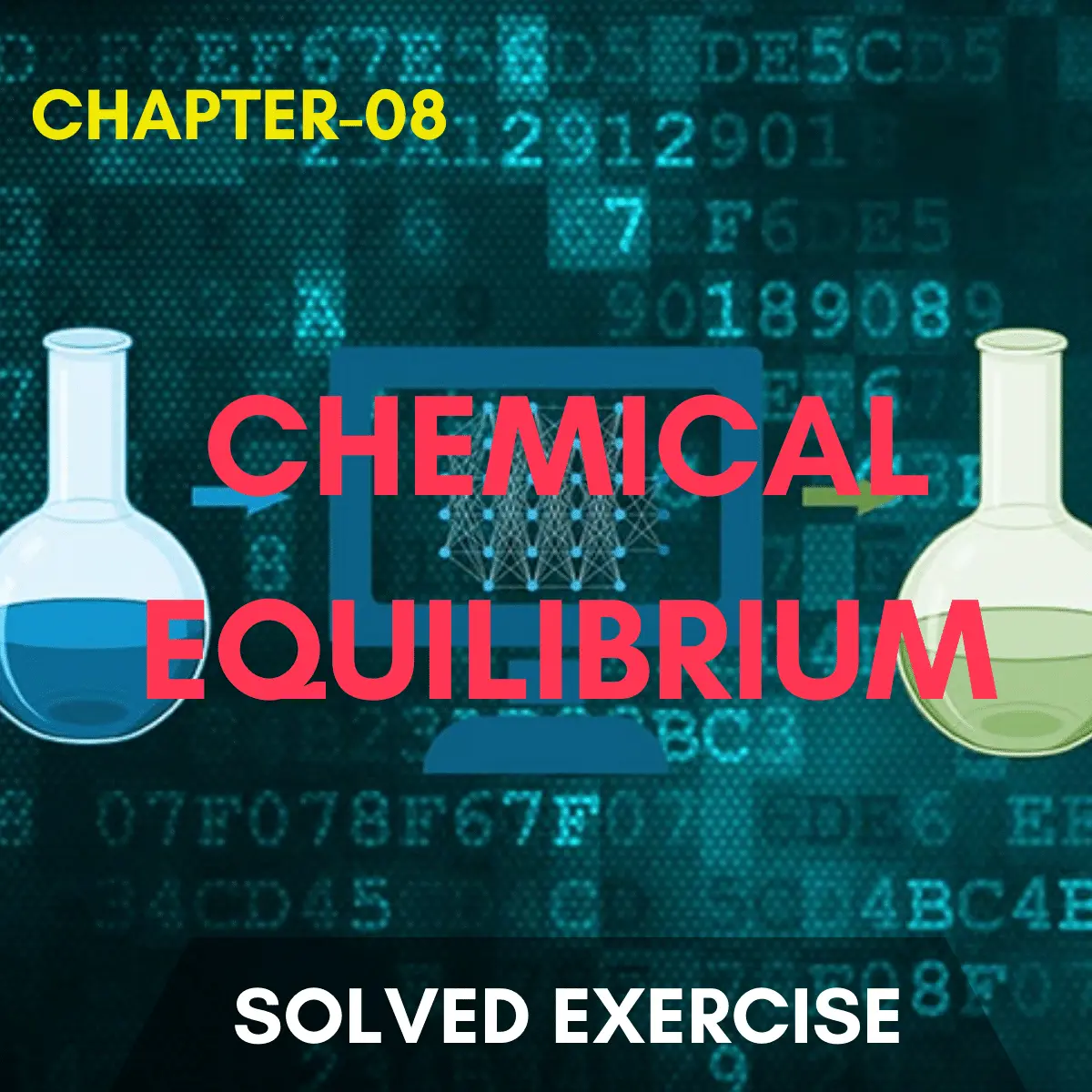CHEMICAL EQUILIBRIUM
Q.01: Choose the correct answer:
(i) For which system does the equilibrium constant, Kc, has units of (conc.)-1?
(a) N2 + 3H2 ⇌ 2NH3
(b) H2 + I2 ⇌ 2HI
(c) 2NO2 ⇌ N2O4
(d) 2HF ⇌ H2 + F2
ANSWER: (c) 2NO2 ⇌ N2O4
EXPLANATION: The units of Kc are obtained by dividing the units of concentration of products in numerator by that of the reactants in denominator, in equilibrium constant expression. Since, in option (c), the number of moles of reactants is twice the number of moles of reactants. Therefore, dividing the concentration units of products by the square of the concentration units of reactants gives the right answer i.e., (Conc.)-1.
(ii) Which statement about the following equilibrium is correct? 2SO2(g)+O2(g) = 2SO3(g) ΔH = –188.3 kJmol-1
(a) The value of Kp falls with rise in temperature.
(b) The value of Kp falls with increasing pressure.
(c) Adding V2O5 catalyst increases the equilibrium yield of SO3.
(d) The value of Kp is equal to Kc.
ANSWER: (a) The value of Kp falls with rise in temperature.
EXPLANATION: The given reaction is exothermic. The increase in temperature will favour the reverse reaction. At equilibrium, the concentration of reactants increases while that of products decreases. As a result, the value of equilibrium constant Kp will fall.
(iii) The pH of 10-3 mole dm-3 of an aqueous solution of H2SO4 is:
(a) 3.0
(b) 2.7
(c) 2.0
(d) 1.5
ANSWER: (b) 2.7
EXPLANATION: The pH is the negative log of H+ ion concentration. Since, 1 mole of H2SO4 ionizes to give two moles of H+ ions, so taking log of 2✕10-3 i.e., pH=-log(2) + -log10-3, gives the right answer as 2.7.
(iv) The solubility product of AgCl is 2.0×10-10 mole2 dm-6. The maximum concentration of Ag+ ions in the solution is:
(a) 2.0×10-10 mol dm-3
(b) 1.41×10-5 mol dm-3
(c) 1.0×10-10 mol dm-3
(d) 4.0×10-20 mol dm-3
ANSWER: (b) 1.41×10-5 moldm-3
EXPLANATION: The solubility product is equal to the product of molar concentrations of the ions raised to the power equal to co-efficients of ions in balanced chemical equation. Since, 1 mole of AgCl will ionize to give maximum of two moles of total ions. Therefore, taking the square root of 2.0×10-10 will give the concentration of each of Ag+ and Cl– ions. Ksp= [Ag+][Cl–] or Ksp=(x)2 OR x=(2.0×10-10)½
(v) An excess of aqueous silver nitrate is added to aqueous barium chloride and precipitate is removed by filtration. What are the main ions in the filtrate?
(a) Ag+ and NO3-1 only
(b) Ag+ and Ba2+ and NO3-1
(c) Ba2+ and NO3-1 only
(d) Ba2+ and NO3-1 and Cl-1
ANSWER: (b) Ag+ and Ba2+ and NO3-1
EXPLANATION: As AgNO3 is in excess, so both Ag+ and NO3-1 ions will remain in the solution. Ba(Cl)2 is relatively in less quantity. So, all of the Cl-1 ions will be precipitated as AgCl. The remaining ions will be Ba+2, Ag+ & NO3-1.
FILL IN THE BLANKS
Q.02: Fill in the blanks.
(i) Law of mass action states that the __________ at which a reaction proceeds, is directly proportional to the product of the active masses of the __________. (rate, reactants)
(ii) In an exothermic reversible reaction, _______ temperature will shift the equilibrium towards the forward direction. (low)
(iii) The equilibrium constant for the reaction 2O3 ⇌ 3O2 is 1055 at 25oC, it tells that ozone is __________ at room temperature. (decomposed)
(iv) In a gas phase reaction, if the number of moles of reactants are equal to the number of moles of the products, Kc of the reaction is __________ to the Kp. (equal)
(v) Buffer solution is prepared by mixing together a weak base and its salt with _________ or a weak acid and its salt with __________. (strong acid, strong base)
TRUE/FALSE
Q.03: Label the sentences as True or False:
(i) When a reversible reaction attains equilibrium both reactants and products are present in a reaction mixture. (TRUE)
(ii) The Kc of the reaction A+B ⇌ C+D is given by Kc=[C][D] /[A][B]. Therefore, it is assumed that: [A]= [B] = [C] = [D] (FALSE)
EXPLANATION: Equilibrium is not the stage of equal concentrations of reactants and products. It is just the stage during a reversible reaction when rates of both forward and reverse reactions become equal. This stage may come near the beginning, in the middle or close to the end of the reaction. The concentrations of reactants and products may differ or equate accordingly.
(iii) A catalyst is a substance which increases the speed of the reaction and consequently increases the yield of the product. (FALSE)
EXPLANATION: A catalyst increases the rates of both forward and reverse reactions. So, it makes the reaction occur faster and decreases the time to reach the equilibrium. But it does not change the position of the equilibrium. Thus, the value of Kc or the product to reactant ratio is not affected which means there is no increase in the yield of the reaction.
(iv) Ionic product Kw of pure water at 25oC is 10-14 mol2 dm-6 and is represented by an expression Kw = [H+][OH–]=10-14 mol2dm-6 (TRUE)
(v) AgCl is a sparingly soluble ionic solid in water. Its solution produces excess of Ag+ and Cl– ions. (FALSE)
EXPLANATION: AgCl is sparingly soluble in water. It means most of the AgCl remains undissociated in the solution, and it does not produce excess of Ag+ and Cl– ions in solution.
TEXTBOOK EXERCISE NUMERICALS

